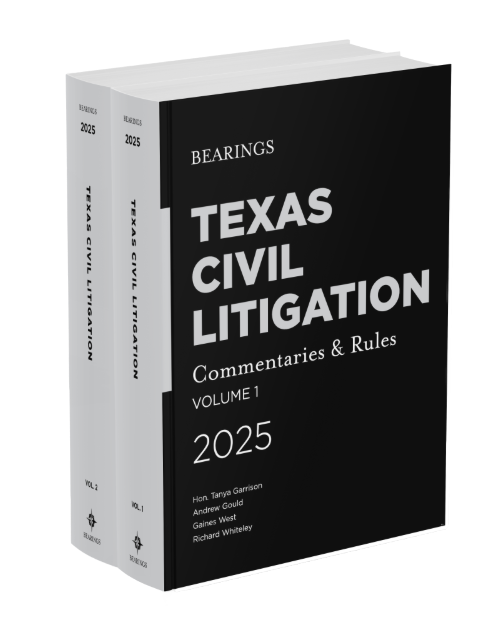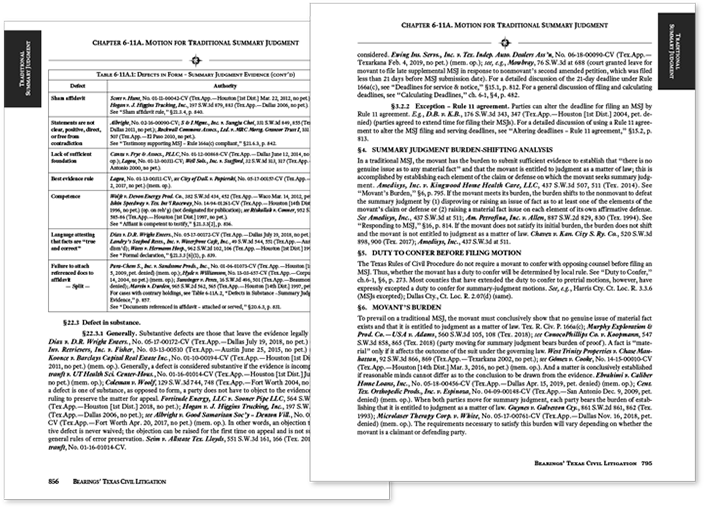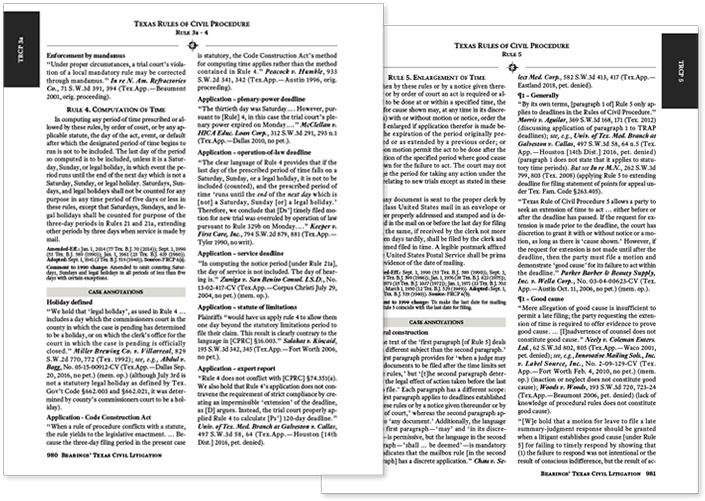
Texas Civil Litigation: Commentaries & Rules
2025 Edition
Bearings’ Texas Civil Litigation: Commentaries & Rules is a must-have civil litigation resource made for today’s practice. The first Texas civil litigation manual written from the ground up in over two decades, this resource represents a modern approach to information design—presenting civil litigation in a manner that is clear, engaging, and easily absorbed and navigated. Starting with over 1300 pages of thoroughly researched commentaries, Bearings' Texas Civil Litigation walks you step-by-step through client intake, presuit evaluation and investigation, pleadings, provisional remedies (including injunctions, sequestration, and receiverships), initial pleas and defensive responses, a wide range of dispositive and nondispositive motions, and discovery. Bearings’ Texas Civil Litigation concludes with Volume 2—over 700 pages that provide all the rules a civil practitioner needs to have at the ready: Texas Rules of Civil Procedure (fully annotated), Texas Rules of Evidence (fully annotated), and Texas Rules of Appellate Procedure. With a diverse editorial board to give you a balanced perspective from different practice areas, locales, and experiences, Bearings’ Texas Civil Litigation will soon be your authoritative go-to resource.
Two volumes means you get more in-depth legal analysis, more annotations, more efficient research (no flipping back and forth between commentaries and rules), and you carry only what you need to court. And with the digital edition, you can access all the content right from your mobile device or computer.
Ch. 1-1: Client Intake
Ch. 1-2: Presuit Evaluation & Investigation
Ch. 2-1: Naming & Joining Parties
Ch. 2-2: Choosing Proper Court (Subject-Matter Jurisdiction)
Ch. 2-3: Choosing Proper Venue
Ch. 2-4: Evaluating Personal Jurisdiction
Ch. 2-5: Evaluating In Rem Jurisdiction
Ch. 2-6: Drafting Original Petition
Ch. 2-7 Serving Process
Ch. 2-8 Pleading for Declaratory Relief
Ch. 3-1: Injunctive Relief
Ch. 3-2: Other Provisional Remedies
Ch. 4-1: Overview of Initial Responses
Ch. 4-2: Answer
Ch. 4-3: Counterclaims, Cross-Claims, & Third-party Claims
Ch. 4-4: Removal to Federal Court
Ch. 6-1: Motion Practice – Generally
Ch. 6-2: Motions Challenging Jurisdiction
Ch. 6-2A: Special Appearance
Ch. 6-2B: Plea to the Jurisdiction
Ch. 6-3: Motion to Transfer - Improper Venue
Ch. 6-4: Motions Concerning Pleadings
Ch. 6-4A: Motion to Dismiss – Rule 91a - Baseless Claim
Ch. 6-4B: Motion to Dismiss – TCPA
Ch. 6-4C: Plea in Abatement
Ch. 6-5: Motions Concerning Attorneys
Ch. 6-5A: Motion to Appear Pro Hac Vice
Ch. 6-5B: Motion to Show Authority
Ch. 6-5C: Motion to Withdraw as Counsel
Ch. 6-5D: Motion to Disqualify Counsel
Ch. 6-5E: Attorney Fees
Ch. 6-6: Motions Challenging Judges
Ch. 6-6A: Motion to Object to Assigned Judge
Ch. 6-6B: Motion to Recuse or Disqualify Judge
Ch. 6-7: Motions Concerning Case Management
Ch. 6-7A: Motion for Severance
Ch. 6-7B: Motion to Consolidate
Ch. 6-7C: Motion for Continuance
Ch. 6-8: Motion for Sanctions – Groundless or Frivolous Papers
Ch. 6-9: Motion for Default Judgment
Ch. 6-10: Motions Concerning Involuntary & Voluntary Dismissal
Ch. 6-10A: Motion for Nonsuit - Voluntary Dismissal
Ch. 6-10B: Motion to Dismiss for Want of Prosecution
Ch. 6-10C: Motion to Reinstate After Dismissal for
Want of Prosecution
Ch. 6-11: Motions Concerning Summary Judgments
Ch. 6-11A: Motion for Traditional Summary Judgment
Ch. 6-11B: Motion for No-Evidence Summary Judgment
Ch. 6-11C: Motion for Hybrid Summary Judgment
Ch. 6-12: Other Pretrial Motions
• Motion To Appoint Guardian Ad Litem
• Motion To Appoint Special Master
• Motion To Refer Case to Court-Ordered ADR
• Motion To Designate Responsible Third Party
• Motion to Take Judicial Notice – Adjudicative Facts
• Motion to Notice & Apply Foreign Law

- Extensive analysis. Comprehensive legal analysis of significant pretrial matters logically organized in an outline format and supported by extensive legal authority.
- Friendly font. World-class Equity font—designed by Matthew Butterick—is specifically designed for legal writing and easy reading.
- Alerts & cautions. Specialized advice, tips, and cautions alert you to unique legal issues and avoidable perils.
- Charts & tables. Charts and tables make difficult and expansive subject matter easier to understand.
- Tabs & headers. Tabs and headers expedite navigation.
- Cross-references. Cross-references direct you to helpful discussions using relevant sections and page numbers.
- Index with page numbers. Comprehensive index with page numbers expedites your research. Who would offer an index without page numbers?

-
Efficient design. Indentations at every rule-section level make the rules
accessible and easy to read. - Strike-through & underscore. Strike-through and underscoring of all rule changes help you quickly identify changes in the law and assess whether the changes impact your case.
-
Annotations. Direct quotations and summations from leading court opinions
provide invaluable interpretative guidance for each rule. - Topical annotation headings. Annotation headings save you time in locating the annotations that are relevant to your issue.
- Cross-references to commentary. Cross-references to relevant commentary discussions help further your research and understanding of the applicable rule.
- Cross-references. Cross-references direct you to helpful discussions using relevant sections and page numbers.
- History notes. Easy-to-read and detailed history notes help you identify a former law and assess an older case’s interpretative value.





